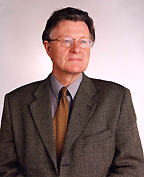
| T H E N I H C A T A L Y S T | S E P T E M B E R – O C T O B E R 2003 |
|
|
|
|
|
FINNISH IMMUNOLOGIST:
NEW FOGARTY SCHOLAR
 |
|
Helgi
Valdimarrson
|
NIH’s newest Fogarty Scholar, Helgi Valdimarsson, will be on campus for three months each fall from 2003 to 2007.
Professor and chair of immunology at the University of Iceland, Reykjavik, Valdimarrson’s early research led to the first report—published in Nature in 1975—of what is now known as natural killer cell activity. He went on to explore the immunological underpinnings of such conditions as rheumatoid arthritis and psoriasis, elucidating the mechanisms of phagocytosis, T-cell recognition of antigens, the MHC system, and other immune system pathways.
His hypotheses, first, that psoriasis is a T-cell–mediated disease and, second, that it is triggered by streptococcal superantigens, changed the way the scientific community views psoriasis. His studies have extended to identifying candidate gene loci for susceptibility to psoriasis and the development of effective immunosuppressive therapies.
In continuing work, Valdimarsson intends to focus on identifying alleles predisposing to psoriasis and autoepitopes recognized by psoriasis-causing T cells. He will also explore the use of psoriasis as a model for autoimmune diseases in general.
While at NIH, he will be hosted by Snorri Thorgeirsson, NCI, and Warren Strober, NIAID, and interact especially with the Immunology and Cytokine Interest Groups.
Strober, chief of the mucosal immunity section, anticipates talking with Valdimarsson about the immunological similarities between psoriasis and Crohn’s disease—especially regarding the proximity on chromosome 16 of loci associated with the two conditions and the potential role of the gene product NOD2. Bacterial involvement in pathogenesis is another commonality and suggests several collaborative laboratory-based studies focused on the possible roles of interferon-g, CD25+ regulatory cells, and TGF-b, Strober says.